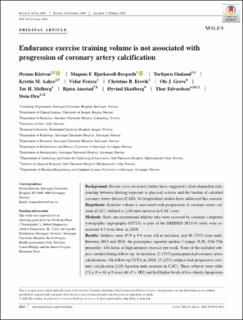| dc.contributor.author | Kleiven, Øyunn | |
| dc.contributor.author | Bjørkavoll-Bergseth, Magnus | |
| dc.contributor.author | Omland, Torbjørn | |
| dc.contributor.author | Aakre, Kristin Moberg | |
| dc.contributor.author | Frøysa, Vidar | |
| dc.contributor.author | Erevik, Christine B. | |
| dc.contributor.author | Greve, Ole Jacob | |
| dc.contributor.author | Melberg, Tor Harald | |
| dc.contributor.author | Auestad, Bjørn Henrik | |
| dc.contributor.author | Skadberg, Øyvind | |
| dc.contributor.author | Edvardsen, Thor | |
| dc.contributor.author | Ørn, Stein | |
| dc.date.accessioned | 2021-03-25T07:17:32Z | |
| dc.date.available | 2021-03-25T07:17:32Z | |
| dc.date.created | 2020-09-14T10:53:27Z | |
| dc.date.issued | 2020 | |
| dc.Published | Scandinavian Journal of Medicine & Science in Sports. 2020, 30 1024-1032. | |
| dc.identifier.issn | 0905-7188 | |
| dc.identifier.uri | https://hdl.handle.net/11250/2735370 | |
| dc.description.abstract | Background
Recent cross‐sectional studies have suggested a dose‐dependent relationship between lifelong exposure to physical activity and the burden of calcified coronary artery disease (CAD). No longitudinal studies have addressed this concern.
Hypothesis
Exercise volume is associated with progression of coronary artery calcium (CAC), defined as ≥10 units increase in CAC score.
Methods
Sixty‐one recreational athletes who were assessed by coronary computed tomography angiography (CCTA) as part of the NEEDED 2013/14 study were re‐assessed 4‐5 years later, in 2018.
Results
Subjects were 45.9 ± 9.6 years old at inclusion, and 46 (74%) were male. Between 2013 and 2018, the participants reported median 5 (range: 0‐20, 25th‐75th percentile: 4‐6) hours of high‐intensity exercise per week. None of the included subjects smoked during follow‐up. At inclusion, 21 (33%) participants had coronary artery calcifications. On follow‐up CCTA in 2018, 15 (25%) subjects had progressive coronary calcification (≥10 Agatston units increase in CAC). These subjects were older (53 ± 9 vs 44 ± 9 years old, P = .002) and had higher levels of low‐density lipoprotein at baseline (3.5 (2.9‐4.3) vs 2.9 (2.3‐3.5) mmol/L, P = .031) as compared to subjects with stable condition. No relationship was found between hours of endurance training per week and progression of coronary artery calcification. In multiple regression analysis, age and baseline CAC were the only significant predictors of progressive CAC.
Conclusion
No relationship between exercise training volume and the progression of coronary artery calcification was found in this longitudinal study of middle‐aged recreational athletes. | en_US |
| dc.language.iso | eng | en_US |
| dc.publisher | Wiley | en_US |
| dc.rights | Attribution-NonCommercial-NoDerivatives 4.0 Internasjonal | * |
| dc.rights.uri | http://creativecommons.org/licenses/by-nc-nd/4.0/deed.no | * |
| dc.title | Endurance exercise training volume is not associated with progression of coronary artery calcification | en_US |
| dc.type | Journal article | en_US |
| dc.type | Peer reviewed | en_US |
| dc.description.version | publishedVersion | en_US |
| dc.rights.holder | Copyright 2020 The Authors. | en_US |
| cristin.ispublished | true | |
| cristin.fulltext | original | |
| cristin.qualitycode | 2 | |
| dc.identifier.doi | 10.1111/sms.13643 | |
| dc.identifier.cristin | 1829597 | |
| dc.source.journal | Scandinavian Journal of Medicine & Science in Sports | en_US |
| dc.source.40 | 30 | |
| dc.source.pagenumber | 1024-1032 | en_US |
| dc.identifier.citation | Scandinavian Journal of Medicine & Science in Sports. 2020, 30 (6), 1024-1032. | en_US |
| dc.source.volume | 30 | en_US |
| dc.source.issue | 6 | en_US |

